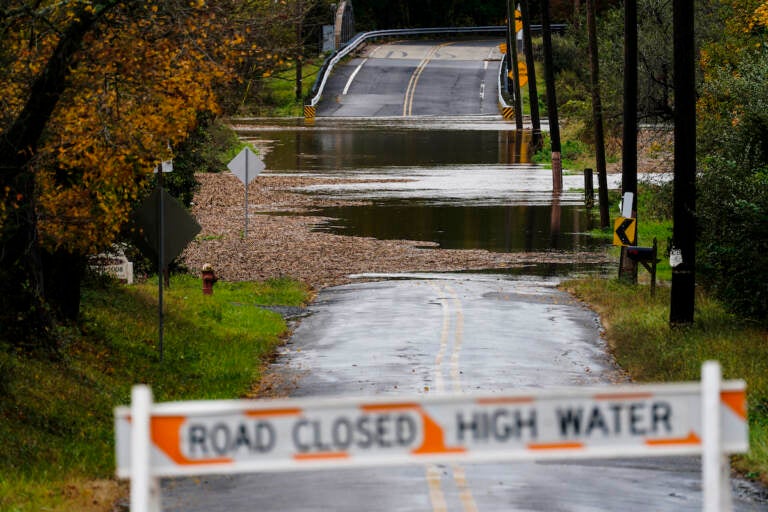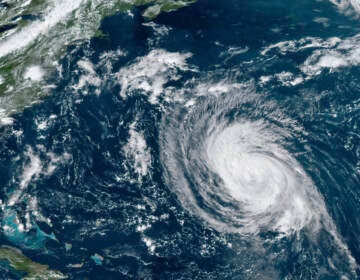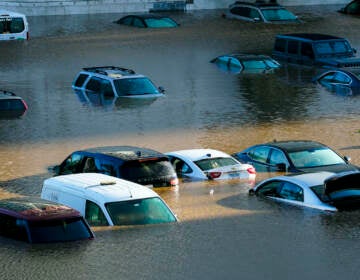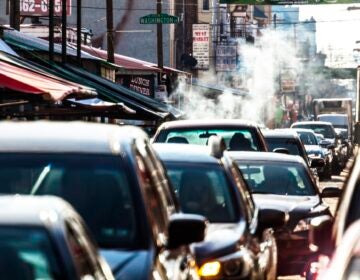Rising sea levels and extreme rainfall: Annual report tells New Jersey planners to brace for climate change impacts
New Jersey is warming at twice the rate of the rest of the continental U.S. A new report is aimed at helping local planners adapt.

File Photo: A barricade blocks access to a road flooded by recent rain in Branchburg, N.J., Tuesday, Oct. 26, 2021. (AP Photo/Matt Rourke)
Increased rainfall in shorter amounts of time, hotter weather, and rising seas are all expected to affect New Jersey residents in the coming decades. Adapting and preparing for these climate impacts will likely fall to local officials. A new report from the New Jersey Climate Change Resource Center at Rutgers University wants to give those decision-makers tools to help plan for increased flooding, heat-related illnesses, and death, as well as the need for additional emergency services.
“One of the big takeaways is we are already seeing the effects of climate change here in New Jersey, and we have a better idea of what climate change in the future will look like,” said James Shope, an applied climatologist with the center and a research associate in the Department of Environmental Sciences at Rutgers.
Shope says the goal of the report released this week, “State of the Climate: New Jersey 2021,” is to compile the most recent climate science in a readable format for local policymakers. He says the center plans to update it every year.
“Adaptation measures have to be informed locally,” Shope said. “For a lot of people, this will be a first overview of ballpark conditions their community may be facing in the future.”
The mid-Atlantic region is warming more rapidly than other parts of the continental U.S. Average temperatures in the state have risen at a rate of about 4 degrees Fahrenheit since 1900, while the national average is about 2 degrees Fahrenheit.
But the reason is unclear.
“There’s a bunch of theories related to waters off the mid-Atlantic being warmer but no one is quite certain as to why. It’s an active area of research,” Shope said.
While the state is warming more than other parts of the country, the rate of sea level rise along the Jersey coast is one of the highest in the world — in part because the state is also sinking.
Average sea level rise could increase an additional one to two feet by 2050, according to the report. The ocean has already risen 18 inches at Atlantic City since measuring began about 100 years ago. While coastal residents have endured repeat floods for decades, inland counties will have to prepare for new and more frequent riverine flooding, according to Shope.
New Jerseyans must prepare for ‘extreme precipitation’
Annual rainfall in New Jersey is expected to increase between 5 and 8% by 2100. The projected range is based on different levels of future carbon emissions. But even more important for planners is the rise in extreme weather events that dump a large amount of precipitation in a short period of time.
Shope points to Tropical Storm Ida last September as a bellwether. The storm killed 30 people in New Jersey after flash floods swamped areas not accustomed to severe torrents.
“So Ida produced a huge amount of rainfall in a short amount of time,” he said. “It’s debatable how much of Ida is related to climate change, but it does provide insight into what it could look like for us in the future when there’s a lot of future rainfall. It underscores how New Jersey is vulnerable to flooding.”
One of the main issues for local planners is accurate and up-to-date flood maps.
“Our flood maps and a lot of our rainfall information is based on historical data,” Shope said. “And that’s fine if the climate is not changing.”
New Jersey’s Department of Environmental Protection launched its Extreme Precipitation Projection Tool this week as part of Earth Week. The tool allows users to drill down to the neighborhood level for information on projected flooding. It aims to correct outdated information that only reflects data up to 2000. The tool developed for the state by Cornell University uses data through 2019.
The updated information shows extreme precipitation increased 10% in some areas. Future projections show precipitation will increase 50% in some northwestern counties by 2100.
“The Extreme Precipitation Projection Tool is an investment in our planet by helping to open our eyes to the realities of climate change-induced flooding and helping us make better decisions on how and where we build,” said New Jersey DEP Commissioner Shawn LaTourette.
The DEP says it wants local agencies, planners, and developers to use the tool to assess stormwater management permits.
WHYY is your source for fact-based, in-depth journalism and information. As a nonprofit organization, we rely on financial support from readers like you. Please give today.







